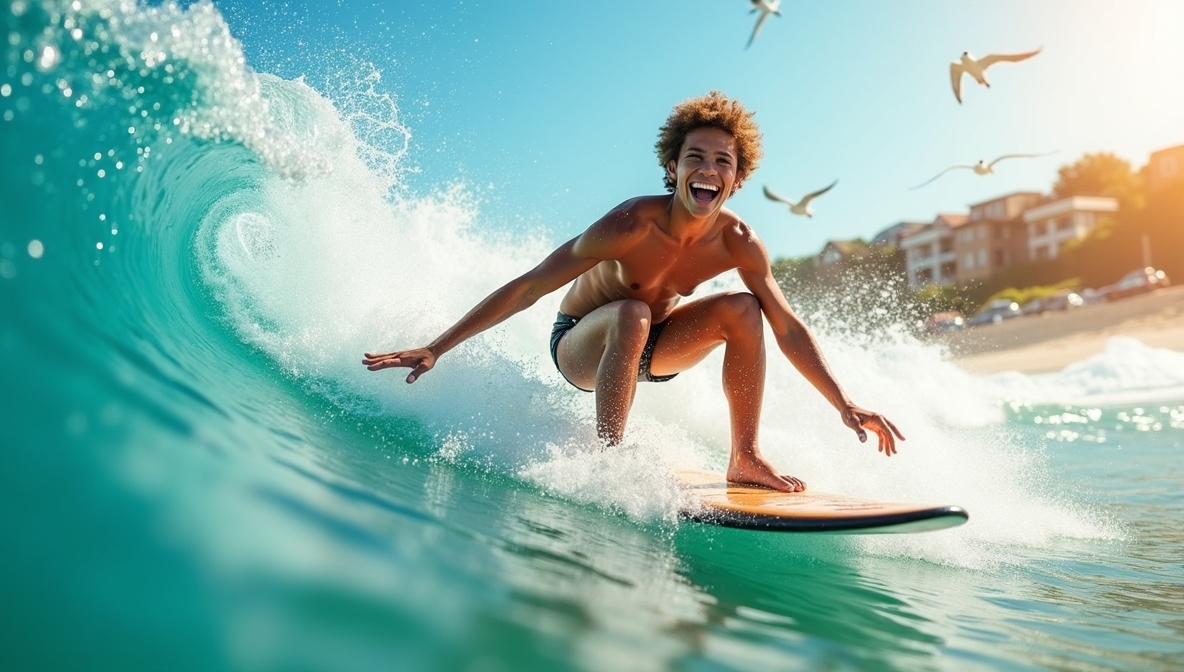Learning to surf can feel like stepping into a new adventure. With the right preparation, understanding, and practice, you’ll ride your first wave confidently in no time. This guide covers essential tips and tricks to help beginners navigate their surfing journey effectively.
Getting Started: What You Need
Essential Gear
- Surfboard: A longboard is ideal for beginners due to its stability and buoyancy.
- Leash: Keeps your surfboard attached to your ankle, preventing it from drifting away.
- Wetsuit: Provides insulation in cold water and protects against abrasions.
- Wax: Applied to your board for better grip and stability.
- Rash Guard: Optional but useful for preventing chafing and sunburn.
Choosing the Right Location
- Gentle Breaks: Find beaches with soft, consistent waves.
- Sandy Bottoms: Safer for falls than rocky or reef-covered areas.
- Crowd Level: Opt for less crowded spots to minimize collisions.
Learning the Basics
Understand the Ocean
- Wave Types: Start with whitewater waves, which are already broken and easier to catch.
- Tides and Currents: Learn how tides and riptides affect wave behavior.
- Surf Forecasts: Use apps or websites to check wave height, direction, and wind conditions.
Paddling Technique
- Lie flat on your board with your chest slightly raised.
- Use long, smooth strokes without splashing to maintain speed.
- Keep your body balanced to avoid tipping.
Catching Your First Wave
- Position: Face your board toward the shore and lie flat.
- Timing: Paddle as the wave approaches, matching its speed.
- Commitment: Keep paddling until the wave lifts your board.
Standing Up
- Pop-Up Drill: Practice on land by pushing your chest up, pulling your legs underneath, and balancing in a low stance.
- Knees: Avoid standing up on your knees, as it disrupts balance.
- Posture: Keep your knees bent, back straight, and eyes focused on where you’re headed.
Key Techniques to Master
Balance and Posture
- Distribute your weight evenly on the board.
- Use your arms to stabilize when feeling off-balance.
- Maintain a low center of gravity to improve control.
Turning Your Board
- Carving: Shift your weight slightly on your back foot while leaning in the direction you want to turn.
- Practice: Start with small turns to get a feel for how the board responds.
Reading the Waves
- Watch experienced surfers to learn how they position themselves.
- Identify where waves break consistently and paddle there.
- Avoid paddling directly into large, breaking waves.
Safety Tips
- Respect Surf Etiquette
- Yield to the surfer closest to the wave’s peak.
- Avoid dropping in on someone else’s wave.
- Apologize if you accidentally breach etiquette.
- Protect Yourself
- Never let go of your board in a crowded lineup.
- If a wave pushes you under, stay calm and let it pass.
- Keep your hands over your head when surfacing to avoid collisions.
- Be Aware of Surroundings
- Check for obstacles like rocks and jetties.
- Stay clear of swimmers and lifeguard zones.
- Understand Riptides
- If caught in a rip, paddle parallel to the shore instead of against the current.
Building Confidence
Start Small
- Limit your sessions to an hour to avoid fatigue.
- Celebrate small achievements, such as catching whitewater or standing up briefly.
Practice Regularly
- Frequent practice helps improve muscle memory and confidence.
- Alternate between practicing pop-ups on land and paddling in water.
Take Lessons
- Professional instructors provide valuable insights and correct bad habits early.
- Group lessons can also be an excellent way to meet fellow beginners.
Progressing to Intermediate Skills
Riding Green Waves
- Paddle out beyond the breaking waves.
- Position yourself on the unbroken part of the wave.
- Practice popping up quickly to catch waves before they break.
Improving Timing
- Observe wave sets to understand their rhythm.
- Position yourself early and start paddling before the wave reaches you.
Building Endurance
- Incorporate exercises like swimming and core workouts into your routine.
- Focus on breath control to stay relaxed during wipeouts.
Common Mistakes to Avoid
- Standing Too Soon
- Wait until the wave propels your board before attempting to stand.
- Poor Board Placement
- Keep the nose of your board slightly above the water to avoid nosedives.
- Overthinking
- Relax and let muscle memory guide your movements.
- Ignoring Warm-Ups
- Stretching prevents cramps and increases flexibility.
Staying Motivated
- Set Goals: Aim to ride a certain number of waves each session.
- Track Progress: Record videos to analyze your technique and improvements.
- Celebrate Wins: Share your milestones with friends or on social media.
Final Thoughts
Surfing combines physical skill and mental focus. Patience, persistence, and proper technique are key. Start small, practice consistently, and enjoy the process of learning to connect with the waves.


